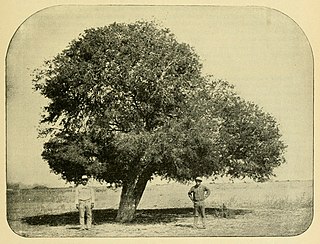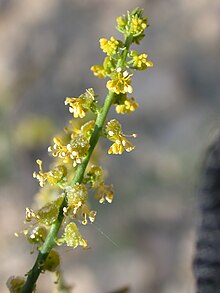
The Brassicales are an order of flowering plants, belonging to the eurosids II group of dicotyledons under the APG II system. One character common to many members of the order is the production of glucosinolate compounds. Most systems of classification have included this order, although sometimes under the name Capparales.

Reseda, also known as the mignonette, is a genus of fragrant herbaceous plants native to Europe, southwest Asia and North Africa, from the Canary Islands and Iberia east to northwest India. The genus includes herbaceous annual, biennial and perennial species 40–130 cm tall. The leaves form a basal rosette at ground level, and then spirally arranged up the stem; they can be entire, toothed or pinnate, and range from 1–15 cm long. The flowers are produced in a slender spike, each flower small, white, yellow, orange, or green, with four to six petals. The fruit is a small dry capsule containing several seeds.

Resedaceae is a family of mostly herbaceous dicotyledonous plants comprising 107 known species in 8 to 12 genera:

The Capparaceae, commonly known as the caper family, are a family of plants in the order Brassicales. As currently circumscribed, the family contains 33 genera and about 700 species. The largest genera are Capparis, Maerua, Boscia and Cadaba.
Ochradenus socotranus is a species of plant in the Resedaceae family. It is endemic to Yemen. Its natural habitat is rocky areas.
Reseda viridis is a species of plant in the family Resedaceae. It is endemic to Socotra. Its natural habitat is rocky areas.
The Japanese Elm cultivar Ulmus davidianavar.japonica 'Reseda' is an American cultivar raised by the Wisconsin Alumni Research Foundation (WARF) as clone no. 43–8. 'Reseda' was grown from seed sent from Hokkaido, Japan, in the late 1950s. Although not released in its own right, it was destined to become the female parent of the highly successful hybrid cultivars 'New Horizon' and 'Rebona'.

Baridinae is a subfamily of true weevils (Curculionidae). It was established by Carl Johan Schönherr in 1836. Some 4,300 species in 550 genera are placed here, most of which occur in the New World. A few are economically significant pests, while others are in turn used for biocontrol of invasive plant pests. This subfamily also contains a few endangered species.

Reseda luteola is a plant species in the genus Reseda. Common names include dyer's rocket, dyer's weed, weld, woold, and yellow weed. A native of Europe and Western Asia, the plant can be found in North America as an introduced species and common weed. While other resedas were used for the purpose, this species was the most widely used source of the natural dye known as weld. The plant is rich in luteolin, a flavonoid which produces a bright yellow dye. The yellow could be mixed with the blue from woad to produce greens such as Lincoln green.
Borthwickia is genus of flowering plants, containing one species, Borthwickia trifoliata from Yunnan, China and Myanmar. The common name in Chinese is 节蒴木. It is a shrub or small tree with evergreen trifoliate leaves, whitish flowers clustered at the tip of the branches, with many stamens, and thin, knobbly, drooping fruits with many small red seeds.

Reseda phyteuma, common name rampion mignonette or corn mignonette, is a species of flowering plant in the family Resedaceae.
Reseda minoica is a species of flowering plant of the genus Reseda found in the eastern Mediterranean region. It was described in 2013 by Santiago Martín-Bravo and Pedro Jiménez-Mejías at the Pablo de Olavide University in Spain. The species has long been confused with closely related species such as R. odorata, R. orientalis and R. balansae, to which it bears a striking resemblance. However, the species can be differentiated from other species by its floral parts. Taxonomic and molecular analyses have further revealed that it is the maternal species of common mignonette, one of the most common sources of fragrance since Ancient Roman times.
Stixis scandens is a species of liana in the family Resedaceae and the type species in its genus. No subspecies are listed in the Catalogue of Life. It is found in Indo-China; in Vietnam it may be called quã dây leo.

Forchhammeria is a genus of plants in the order Brassicales. This genus has previously been placed in the Stixaceae and Capparaceae, but under the APG IV system is now included in the family Resedaceae. Species can be found in Central America and the Caribbean.

Colletes similis is a species of plasterer bee belonging to the family Colletidae, subfamily Colletinae.

Hylaeus communis is a Palearctic species of solitary bee.
Oligomeris is a genus of flowering plants belonging to the family Resedaceae.
Sesamoides is a genus of flowering plants belonging to the family Resedaceae.
Randonia is a monotypic genus of flowering plants belonging to the family Resedaceae. The only species is Randonia africana.









